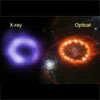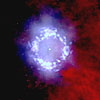CXC Home | Search | Help | Image Use Policy | Latest Images | Privacy | Accessibility | Glossary | Q&A
Chandra Timelapse Movie of SN 1987A
Quicktime MPEG This sequence shows how the X-ray emission from Supernova 1987A (known as SN 1987A) has brightened from 1999 to 2005. The X-rays are produced when a shock wave from the supernova collides with the cooler, outer layers shed before the star exploded. As the shock wave plows deeper into the cool cloud the ring should become larger and much brighter in both optical and X-ray light.
[Runtime: 0:47]
(Credit: X-ray Images: NASA/CXC/PSU/S.Park & D.Burrows. Optical Image: NASA/STScI/CfA/P.Challis et al.)
Quicktime MPEG This sequence shows how the X-ray emission from Supernova 1987A (known as SN 1987A) has brightened from 1999 to 2005. The X-rays are produced when a shock wave from the supernova collides with the cooler, outer layers shed before the star exploded. As the shock wave plows deeper into the cool cloud the ring should become larger and much brighter in both optical and X-ray light.
[Runtime: 0:47]
(Credit: X-ray Images: NASA/CXC/PSU/S.Park & D.Burrows. Optical Image: NASA/STScI/CfA/P.Challis et al.)
Animation of a Supernova
Quicktime MPEG When a massive star explodes, as in the case of SN 1987A, it creates a shell of hot gas that glows brightly in X-rays. SN 1987A occurred in the Large Magellanic Cloud, a galaxy only 160,000 light years from Earth. The outburst was visible to the naked eye, and is the brightest known supernova in almost 400 years.
[Runtime: 0:16]
(Animation: CXC/D.Berry & A.Hobart)
View Still Photos
Field Guide: Supernovas & Supernova Remnants
Quicktime MPEG When a massive star explodes, as in the case of SN 1987A, it creates a shell of hot gas that glows brightly in X-rays. SN 1987A occurred in the Large Magellanic Cloud, a galaxy only 160,000 light years from Earth. The outburst was visible to the naked eye, and is the brightest known supernova in almost 400 years.
[Runtime: 0:16]
(Animation: CXC/D.Berry & A.Hobart)
View Still Photos
Field Guide: Supernovas & Supernova Remnants
Return to Supernova 1987A (17 Aug 05)




